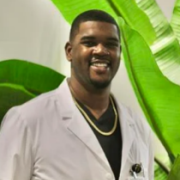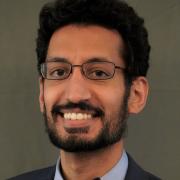My first in-person fellowship meeting in Sacramento brought chills of excitement. What I heard that day from inspiring speakers, including former fellows at the forefront of public health and policy change, was inspiring. I realized this is what I had been looking for to complement my direct patient care by serving my community in a meaningful way.
As physicians, we learn to make rapid assessments and come up with solutions for our patients’ problems, sometimes within minutes. Changing policy, environment, and systems requires a different approach that is not taught in medical school. This is where the Champion Provider Fellowship comes into play.
When my current supervisor, Dr. Gina Johnson, a previous Champion Provider Fellow, recommended I apply to the same fellowship I immediately jumped at the opportunity because I wanted to do more than just spend a few minutes with each patient. Admittedly, I did not really grasp the full scope of what I was signing up for. I recently obtained a master’s degree in healthcare quality and safety management but was still figuring out how to apply this to my clinical work and improve the lives of my patients.
At the onboarding, I met a previous fellow, Dr. Lena Al-Sarraf, who is also a medical provider in Los Angeles County. She shared with me about her project with the LA Food Bank addressing food insecurity, which she pushed to implement during her time as a Fellow. Dr. Al-Sarraf’s story and her project had my mind racing and as soon as I was back at my clinic, I called my local health department and CalFresh Healthy Living liaison, Fatinah Darwish, to discuss how to pick up where Dr. Al-Sarraf left off. Fatinah connected me with the Los...
Dental care is crucial for both maternal and child health, yet it is often overshadowed by numerous other health priorities during pregnancy. The absence of pain is not the absence of dental disease, and the consequences of neglecting oral health can be severe. For perinatal mothers, poor oral health has been linked to adverse pregnancy outcomes, and in children, to poor developmental trajectories.1
The poignant case of Jessica, a 28-year-old first-time mother and a patient at our clinic, tragically underscores the dire consequences of overlooking dental health. Due to misconceptions about the safety of dental treatments during pregnancy, such as concerns around bacteria translocation and increased risk of infection, Jessica avoided dental care during the first trimester of her pregnancy. Only when faced with debilitating pain and swelling did she seek help. Unfortunately, her delayed action led to an advanced infection that escalated to septic shock, multiple organ failure, and ultimately spread to her brain. Despite being placed in an induced coma to sustain her pregnancy, Jessica passed away after her child was delivered via C-section. Jessica never got the chance to meet or hold her baby, leaving behind a child to grow up without a mother.
This tragedy could have been prevented with earlier dental intervention. Jessica’s story highlights the urgent need for mandatory referrals from OB/GYN to dental services at the first prenatal visit.
In light of Jessica’s story and similar other tragedies, I am advocating for the immediate implementation of mandatory dental referrals and establishing dental clearance as a standard of care for pregnant women within state-funded and private...
“Help! I need a doctor!” Mona’s mother was frantic. “She’s in pain. Someone please help!” Mona, a four-year-old girl who loves chocolate milk, was wailing in fear in my dental chair.
Finally, after I delivered the anesthetic, Mona’s tooth was numb. I was seeing Mona for her second emergency tooth extraction. This is not how I wanted the situation to play out, but Mona was a fearful four-year-old with cavities. Typically, a child with this much dental fear is treated with sedation to make the extraction procedure more comfortable and less anxiety-inducing. However, my next available dental sedation appointment was 10 months away because so many other patients also needed treatment for similar dental disease. Furthermore, Mona was overweight, which made sedation relatively contraindicated due to increased risks of adverse outcomes. The only help that I could offer was an emergency extraction. I reassured Mona’s mother, “Mona’s tooth is getting numb. It’s not pleasant but I assure you she is not feeling pain.” Six minutes later, after tears, more anxious cries and a skillful tug, the tooth was out.
Chocolate milk was new to Mona a few months ago. She entered transitional kindergarten last fall and fell in love with it. Soon, mom was buying chocolate milk for home, too. Since starting school, Mona would no longer accept plain milk and the extra calories contributed to Mona’s weight gain, increasing her risks for adverse health consequences like diabetes and hypertension. Sadly, Mona was not alone. Children get a taste for cavity-causing sugar-sweetened beverages, like juice and chocolate milk, that are introduced and made available at schools and daycare.
As...
Youth mental health is the defining public health crisis of our time.
-Vivek Murthy, US Surgeon General
There is a crucial need for more mental health care support in our country. Today, 157 million Americans live in areas with a shortage of mental health providers. (1) Limited provider capacity means that of the 46% of young adults who have diagnoses of substance abuse or mental illness, 55% of them receive no care. (2) And for historically underserved communities, including BIPOC and LGBTQ+ populations, finding a culturally sensitive provider can be even more challenging. (3)
I’m a doctor. A doctor’s toolbox includes medical education and training, a license to diagnose, and the ability to prescribe treatment. So, when a colleague suggested that unlicensed folks with lived experience might be as good or even better at meeting the needs of people who are struggling with mental health, you might think that I’d be skeptical.
As I looked at the literature on peer support, I realized that the model of connecting those who have lived through the same struggles has been helping people for decades outside of clinical settings. Communities for people who are mutually struggling with grief and addiction (4), for example, are trusted and commonplace. No one can better understand what it is like to lose a loved one or to hit rock bottom than someone who has been there, too. It’s why groups of people continue to gather week after week, year after year, in church basements and recreation centers, to support each other in ways that friends or doctors never could. It’s why people living...
It has been a challenging few years, learning to connect with patients while hiding my smile behind a facemask, in an environment where trust in the medical establishment has decreased and social media memes have become absolute truth. But screening for food insecurity has become a secret weapon for building rapport with my patients and fulfilling my calling as a pediatrician at a federally qualified health center serving an underserved community. When I walk into an exam room with a guide to healthy food resources in my hand, knowing that the family in front of me has limited access to food, I immediately connect with them on a personal level. We may not agree that today is the right day for their child to be vaccinated or that their child may benefit from weight loss, but we can unite on the fact that $7 for a dozen eggs is too expensive and $5 for a gallon of gas causes us to modify our spending habits. Our therapeutic alliance rests on the reality that so many people in our country are facing food insecurity, that our health center has recognized this and provided opportunities for me, their pediatrician, to address it.
Food insecurity is common. Nationally, 12.8% of families are food insecure. (1) Food insecurity may result in changes in eating habits, like consuming more calorie-dense and low nutritional value foods that tend to be more affordable and accessible. (2)(3) These habits can increase the likelihood of children developing chronic diseases like obesity. (4) Children also experience toxic stress associated with intense short-term and long-term food insecurity, even when their parents attempt to shield them from experiencing hunger. (4) This stress contributes to an increased risk...
Jasmine, a first-generation immigrant from the Middle East, was one of the first patients I cared for when I transitioned from private practice to public health dentistry. She had only been in the States for a few years and was raising three children, including a 17-year-old son with developmental delays. She was computer savvy and her ability to navigate complex systems, including medical and dental care, was impressive. When I met Jasmine, it appeared that she had everything under control.
Yet, when she and her children stepped into my dental chair, I found signs of rampant decay and poor oral health. Despite their relatively uneventful medical histories, I noticed some underlying issues that needed attention.
Jasmine’s daughter appeared obese at only 14 years old. Jasmine had expressed that her daughter had been complaining about sporadic dizziness, which she attributed to pubertal changes. As a dentist, I recognized the interconnectedness between oral health and overall well-being. I took her blood pressure, which I was surprised to find was elevated and indicated early stage 1 hypertension.
This was a wake-up call for me. How many cases of childhood hypertension are going unnoticed? And more importantly, how many could be prevented if the underlying issues leading to childhood obesity and unhealthy eating were being addressed more proactively?
I spoke with Jasmine, and it soon became clear to me that her story was more than just a tale of dental struggles or deficient knowledge about healthy food and beverage choices. She understood that what goes in her mouth affects her overall health, but she also pointed out that eating healthy requires time, money, and access to...
Anthony is a 17-year-old young man who was brought to my clinic by his mother for behavioral concerns.
“He’s spending more and more time alone in his room”.
Anthony sits on the exam table with his shoulders slumped, eyes down, fidgeting with his hands.
“I don’t know why she brought me here. I’m fine.” he says.
He looks tired, so I ask about how he’s been sleeping. Before he can answer, his mother chimes in, “He stays up all night on his iPhone.” She shares that when she has tried to restrict his phone use, she later awakens to find him hiding in his bed under the sheets staring at the screen.
“It’s not that bad, some of my friends don’t go to bed until 2:00 in the morning!” he argues.
“Are you tired?” I ask him.
“Nah, I just drink a Red Bull and I’m fine.” he replies. His mom contends that he often sleeps in, is late for school, and he has also been falling asleep after school.
As his mom starts to tear up, he admits “I do feel bad because my mom keeps getting letters from school when I’m late and it’s stressing her out. I tried to cut back on using my phone at night, but I just can’t seem to stop. All my friends are texting and posting. I don’t want to be left out. I want to know what’s going on and that keeps me up.”
His mother shares that his teacher is concerned about his failing grades, poor concentration and how he constantly has his phone out during class. “What?” he interjects. “Everyone else is on their phones too! It’s not my fault that TikTok memes are more interesting than math!”
I notice that he has gained a lot of weight since our last appointment. He discloses that sometimes he just doesn’t have an appetite...
I wear three hats in my professional life:
- I’m a pediatrician working primarily with under-resourced and historically marginalized patient populations.
- I’m a nature champion, promoting the health benefits of spending time outside in nature.
- I’m part of a leadership team that advocates for anti-racism, diversity, equity, inclusion, and justice in patient care.
For many who see my work from the outside, my hats all seem separate, but, for me, these three roles work synergistically to allow me to help my patients access significant and lasting health benefits.
Health Benefits of Nature
Numerous studies link spending time outside to experiencing better health outcomes including lower blood pressure and heart rate, better immune system function, lower levels of stress, and decreased risk of chronic diseases like diabetes and cardiovascular disease. Studies also demonstrate a link between nature exposure and improved cognitive function and development, brain activity, sleep, and mental health (including decreased risk of depression and anxiety).(1) But as many as 100 million people in the U.S. — 30 percent of the population — lack access to the benefits parks and green spaces provide.(2)
Inequities in Park Access
Many historically marginalized communities cannot access high-quality and safe parks and green spaces due to a combination of racial and economic disparities. This may mean that these resources do not exist near them, or, if they do, they may have damaged play equipment, be poorly maintained, or have criminal activity or other conditions that make the parks feel unsafe. A lack...
I recently celebrated with one of my patients as she met a major health goal: she maintained well-controlled blood sugar and blood pressure levels for a full year. In the eight years since our first visit, she struggled with consistent management of her diabetes, in large part due to challenges affording medications and nutritious food. In addition to caring for her two young children, she spent years as the primary supporter for her mother who suffered from complications from a severe stroke. Witnessing her mother’s decline in health only furthered this resilient young woman’s resolve to improve her own health, and I was excited to see her making progress towards this precious goal.
Sadly, our shared joy was tempered by the harrowing realization that she might soon lose access to essential safety net services that buoyed the improvements in her health. We both knew that a significant part of her success was based on consistent Medi-Cal coverage and access to associated anti-hunger and anti-poverty support programs. The end of the federal COVID-19 Public Health Emergency (PHE) declaration on May 11, 2023, marked a reversal or regression of hundreds of federal and state legislative flexibilities that allowed for expansion of Medi-Cal services for the most vulnerable communities in California.
Major Risks of the Great Unwinding of Medi-Cal Enrollments
For my patient and millions of other Californians who live at the margins of the social safety net, a critical piece of federal legislation prevented eligible patients from automatic disenrollment from Medi-Cal throughout the height of the COVID...
While you might think there isn’t much overlap between the goals of a family medicine physician and a pediatric dentist, we have a shared understanding about the harmful effects of sugar-sweetened beverages (SSB) on the health of young children. We have both witnessed first-hand the increase in SSB-related poor health outcomes, especially during the COVID-19 pandemic. Our patients consumed higher than usual SSBs that coupled with experiencing a lack of access to physical activity, not surprisingly, increased the cases of obesity and/or dental caries in our practices.
When looking at BMI among San Diego school children, nearly 1 out of every 3 children were overweight or obese in the 2017-18 school year.1 In terms of their oral health, according to data from the Oral Health Assessment 2017-18, 27% of kindergartners and first graders already experienced tooth decay or restorations, and 21% had visible decay with 4% needing urgent dental services.2 These numbers were pre-pandemic and already shocking. Here are our personal experiences treating patients during the pandemic:...







